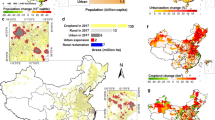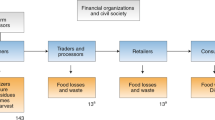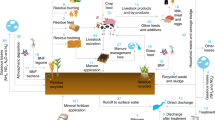Abstract
Nitrogen pollution is an important environmental issue gaining traction in policy circles. However, there is little understanding of current nitrogen policies around the world: whether they account for nitrogen’s unique ability to exacerbate multiple environmental impacts or balance nitrogen’s dual role as an essential agricultural input and major pollutant. Here we assemble and analyse the first database of nitrogen policies generated by national and regional legislatures and government agencies, a collection of 2,726 policies across 186 countries derived from the ECOLEX database. The database covers all major environmental sinks (such as air, water and climate), economic sectors (including agriculture, wastewater and industry) and policy instruments (from market mechanisms to regulatory standards). We find that sink-centred policies are focused predominantly on water, mirroring the distribution of nitrogen’s global environmental and human health costs. However, policy integration across sinks is severely lacking, which heightens the risk of substituting one form of nitrogen pollution for another. Moreover, two-thirds of agricultural policies (ranging from broad sectoral programmes to nitrogen-specific measures) incentivize nitrogen use or manage its commerce, demonstrating the primacy of food production over environmental concerns.
This is a preview of subscription content, access via your institution
Access options
Access Nature and 54 other Nature Portfolio journals
Get Nature+, our best-value online-access subscription
$29.99 / 30 days
cancel any time
Subscribe to this journal
Receive 12 digital issues and online access to articles
$119.00 per year
only $9.92 per issue
Buy this article
- Purchase on Springer Link
- Instant access to full article PDF
Prices may be subject to local taxes which are calculated during checkout



Similar content being viewed by others
Data availability
A preliminary version of the nitrogen policy database developed and described in this paper can be accessed here: https://docs.google.com/spreadsheets/d/1hOfl5Np80oC4EXrNMi7emnhx3RByRFSvOfEr9f2GJC4/edit?usp=sharing. A more user-friendly version will soon be made available via the www.inms.international website. The original database used to compile our nitrogen database is ECOLEX, which can be accessed at www.ecolex.org.
References
Fowler, D. et al. Effects of global change during the 21st century on the nitrogen cycle. Atmos. Chem. Phys. 15, 13849–13893 (2015).
Sutton, M. et al. in Frontiers 2018/19: Emerging Issues of Environmental Concern (ed. UNEP) Ch. 4 (UNEP, 2019).
Galloway, J. N. et al. The nitrogen cascade. BioScience 53, 341–356 (2003).
Lade, S. J. et al. Human impacts on planetary boundaries amplified by Earth system interactions. Nat. Sustain 3, 119–128 (2020).
Steffen, W. et al. Planetary boundaries: guiding human development on a changing planet. Science 347, 1259855 (2015).
Davidson, E. A. & Kanter, D. Inventories and scenarios of nitrous oxide emissions. Environ. Res. Lett. 9, 105012 (2014).
Sustainable Nitrogen Management Resolution UNEA/EA.4/L.16 (United Nations Environment Assembly, 2019).
Colombo Declaration on Sustainable Nitrogen Management. United Nations Global Campaign on Sustainable Nitrogen Management (United Nations, 2019).
Sutton, M. A. et al. The European Nitrogen Assessment (Cambridge Univ. Press, 2011).
Tomich, T. P., Brodt, S. B., Dahlgren, R. A. & Scow, K. M. (eds) The California Nitrogen Assessment: Challenges and Solutions for People, Agriculture, and the Environment (Univ. of California Press, 2016).
Abrol, Y. P. et al. The Indian Nitrogen Assessment: Sources of Reactive Nitrogen, Environmental and Climate Effects, Management Options and Policies (Elsevier, 2017).
Kanter, D. R. & Brownlie, W. J. Joint nitrogen and phosphorus management for sustainable development and climate goals. Environ. Sci. Policy 92, 1–8 (2019).
Policies Database (International Energy Agency, 2019); https://www.iea.org/reports/world-energy-model/policies-database
Climate Policy Database (NewClimate Institute, 2015); http://climatepolicydatabase.org/index.php/Climate_Policy_Database
Department of Environmental Affairs National Biodiversity Strategy and Action Plan (Republic of Botswana, 2016).
Terms and Procedure for Registration of Inorganic Fertilizer Regulation of the Minister of Agriculture of RI Number 43/Permentan/SR.140/8/2011 (Republic of Indonesia, 2011).
Sobota, D. J., Compton, J. E., McCrackin, M. L. & Singh, S. Cost of reactive nitrogen release from human activities to the environment in the United States. Environ. Res. Lett. 10, 025006 (2015).
Kanter, D. R. Nitrogen pollution: a key building block for addressing climate change. Clim. Change 147, 11–21 (2018).
Velthof, G. L. et al. The impact of the nitrates directive on nitrogen emissions from agriculture in the EU-27 during 2000–2008. Sci. Total Environ. 468, 1225–1233 (2014).
Aillery, M. et al. Managing Manure to Improve Air and Water Quality Economic Research Report 9 (USDA Economic Research Service, 2005).
Xepapadeas, A. The economics of non-point-source pollution. Annu. Rev. Resour. Econ. 3, 355–373 (2011).
Drawing Down N2O to Protect Climate and the Ozone Layer: A UNEP Synthesis Report (UNEP, 2013).
Global Non-CO2 Greenhouse Gas Emission Projections & Mitigation: 2015–2050 (EPA, 2019).
Robertson, G. P. et al. Nitrogen–climate interactions in US agriculture. Biogeochemistry 114, 41–70 (2013).
Kanter, D. R. et al. A framework for nitrogen futures in the Shared Socioeconomic Pathways. Glob. Environ. Change 61, 102029 (2020).
Rao, S. et al. Future air pollution in the Shared Socio-economic Pathways. Glob. Environ. Change 42, 346–358 (2017).
Food and Agriculture (OECD, 2012).
USDA Agricultural Projections to 2022 (USDA, 2013).
Nemet, G. F., Holloway, T. & Meier, P. Implications of incorporating air-quality co-benefits into climate change policymaking. Environ. Res. Lett. 5, 014007 (2010).
Senet, S. First European agreement on recycled fertilisers. EURACTIV (19 December 2018); https://go.nature.com/31bKSH3
Erisman, J. W., Bleeker, A. & van Jaarsveld, J. A. Evaluation of ammonia emission abatement on the basis of measurements and model calculations. Environ. Pollut. 102, 269–274 (1998).
Oenema, O. et al. Nitrogen Use Efficiency (NUE): An Indicator for the Utilisation of Nitrogen in Agriculture and Food Systems (Wageningen Univ., 2015).
Coggan, A., Whitten, S. M. & Bennett, J. Influences of transaction costs in environmental policy. Ecol. Econ. 69, 1777–1784 (2010).
Oenema, O. et al. in The European Nitrogen Assessment (eds Sutton, M. A. et al.) Ch. 4 (Cambridge Univ. Press, 2011).
Kanter, D. R. & Searchinger, T. D. A technology-forcing approach to reduce nitrogen pollution. Nat. Sustain. 1, 544–552 (2018).
Stuart, D., Schewe, R. L. & McDermott, M. Reducing nitrogen fertilizer application as a climate change mitigation strategy: understanding farmer decision-making and potential barriers to change in the US. Land Use Policy 36, 210–218 (2014).
Reimer, A. P., Denny, R. C. H. & Stuart, D. The impact of federal and state conservation programs on farmer nitrogen management. Environ. Manage. 62, 694–708 (2018).
Kanter, D. R. et al. Nitrogen pollution policy beyond the farm. Nat. Food 1, 27–32 (2020).
Booth, S. Analysis of Existing Environmental Policy Databases (UNEP, 2017).
Sutton, M. A. et al. Our Nutrient World: The Challenge to Produce More Food and Energy with Less Pollution. Global Overview of Nutrient Management (Centre for Ecology and Hydrology, Edinburgh on behalf of the Global Partnership on Nutrient Management and the International Nitrogen Initiative, 2013).
Acknowledgements
We gratefully acknowledge funding from the International Nitrogen Management System, which is itself funded by the Global Environment Facility through the United Nations Environment Programme.
Author information
Authors and Affiliations
Contributions
D.R.K. conceived and led the project, analysed and interpreted the data and led drafting of the paper. O.C., O.N. and M.R. analysed and interpreted the data and contributed to the drafting of the paper. W.W. interpreted the data and contributed to the drafting of the paper.
Corresponding author
Ethics declarations
Competing interests
The authors declare no competing interests.
Additional information
Publisher’s note Springer Nature remains neutral with regard to jurisdictional claims in published maps and institutional affiliations.
Supplementary information
Rights and permissions
About this article
Cite this article
Kanter, D.R., Chodos, O., Nordland, O. et al. Gaps and opportunities in nitrogen pollution policies around the world. Nat Sustain 3, 956–963 (2020). https://doi.org/10.1038/s41893-020-0577-7
Received:
Accepted:
Published:
Issue Date:
DOI: https://doi.org/10.1038/s41893-020-0577-7
This article is cited by
-
Agricultural water demand is taxing regional water supplies
Nature Water (2024)
-
Agri-environmental policies from 1960 to 2022
Nature Food (2024)
-
Indian interstate trade exacerbates nutrient pollution in food production hubs
Communications Earth & Environment (2024)
-
Identifying leverage points for sustainable nutrient policy integration in Canada
Ambio (2024)
-
Addressing global environmental pollution using environmental control techniques: a focus on environmental policy and preventive environmental management
Discover Environment (2024)



